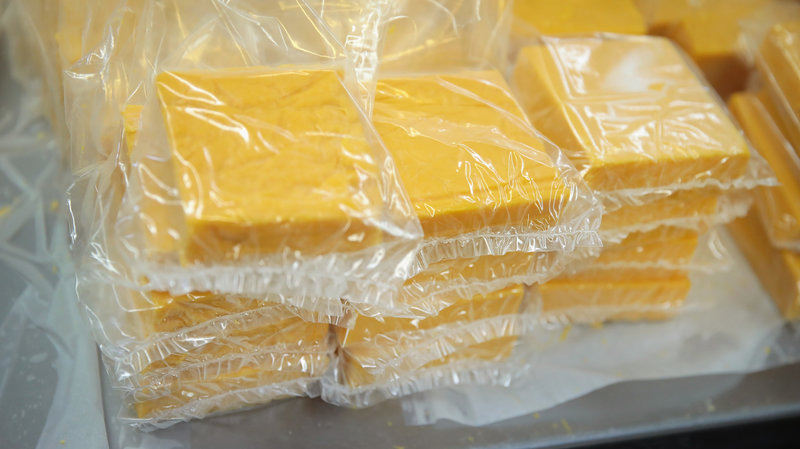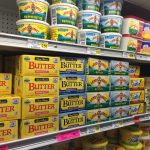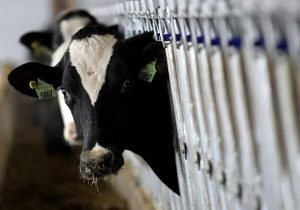
The Cheddar blocks shot up to $1.73 per pound Wednesday, highest CME price since Oct. 1, but offers took them backward to close Friday at $1.6450, still up 7 1/2-cents on the week and 11 1/2-cents above a year ago.
The barrels finished at $1.6025, up 3 3/4-cents, highest since Sept. 4 and 16 1/4-cents above a year ago.
One car of block traded hands on the week and 41 of barrel, with 143 loads of barrel for the month.
Monday saw the blocks inch down a half-cent, then gain a penny Tuesday, hitting $1.65. The barrels lost a penny and a quarter Monday and stayed there Tuesday at $1.59.
Traders Friday anticipated Tuesday’s Global Dairy Trade auction and the February Dairy Products report on Wednesday.
Meanwhile, Midwestern cheese makers report that orders seem to have picked up over the last few weeks, according to Dairy Market News.
Barrel producers report an increase in buyer interest and the uptick in sales is matching seasonal expectations, as warmer weather elicits hopes of a strong grilling season.
Milk is in good balance with processing needs, with a few more spot milk loads available. Prices ranged from $1 above to $1.25 under class but cheesemakers have mixed feelings on taking on extra milk, says DMN, with some content to use only their own patrons’ milk or the milk they normally receive from current agreements. They also desire to keep inventories capped.
Others will take on milk, especially if it can be matched to an extra cheese order. Bottom line: Cheese market prices are infusing a dose of uncertainty into the market.
Western cheese demand is steady and some manufacturers note an increase in barrel purchases the last few weeks. Inventories remain heavy and end users say they are getting plenty of offers.
Strong milk production is filling Western cheese vats, says DMN, but “the new federal milk market order in California is reshuffling how milk flows into manufacturing facilities. Some plants are holding back on production, while others are shifting production away from American-style cheeses. In some cases, cheesemakers are switching some production to other natural cheeses or specialty cheeses.
“In other cases, the manufacturer is diverting milk into other dairy product processing altogether. The net effect is less cheese being made in the state and more butter and milk powder.”
Butter made it to $2.28 per pound last Monday but ended Friday at $2.2550, down a penny on the week but 4 cents above a year ago, on 2 sales for the week.
It was down a half-cent Monday and held there Tuesday at $2.25.
Central region cream is readily accessible to most butter makers, according to DMN, but Class II and other users are actively drawing cream as well and cream is expected to tighten a bit. Inventories are adequate to satisfy all buyers’ needs.
Western butter processing is going at a heavy pace as producers continue to build inventories for future usage. Cream loads are available to western manufacturers, says DMN, but discounted prices cannot be easily found. Butter sales to retailers and to food service remain good since holiday demand is being filled. With the baking season approaching, butter orders are likely to pick up. Butter stocks are plentiful and growing “to the satisfaction of manufacturers,” though a few contacts report inventories are below last year volumes.
Grade A nonfat dry milk closed Friday at 96 1/4-cents per pound, up a half-cent on the week and 27 1/4-cents above a year ago.
Monday’s powder was down a quarter-cent but jumped a penny and a half Tuesday, to 97 1/2-cents per pound.
The dry whey price closed Friday at 32 1/4-cents per pound, down three quarter cents on the week but 3 3/4-cents above a year ago, with 26 sales on the week.
The whey added three-quarters Monday and another quarter-cent Tuesday to hit 33 1/4-cents per pound.
GDT up 0.8%
Tuesday’s Global Dairy Trade auction registered its ninth consecutive session of gain but rose just 0.8% on the weighted average of products offered. That compares to the March 19 gain of 1.9% which followed a 3.3% jump on March 5. Sellers brought 17.9 million pounds of product to the market, down from 47.9 million March 19 and the smallest total since April 3, 2018.
The gains were again led by rennet casein, up 7.5%. Butter was up 5.8%, following a 9.3% jump on March 19. Buttermilk powder was up 5%, anhydrous milkfat was up 3.7%, after it dipped 3.1% in the last event, and GDT Cheddar was up 3.2%, after it gained 3.9%.
Lactose was down 5.3% and whole milk powder was off 1.3%, following a 4% rise last time.
Milk feed ratio up
A rise in the U.S. All Milk price average and a lower soybean price nudged the February milk feed price ratio a little higher for the second month in a row.
The Agriculture Department’s latest Ag Prices report put the February ratio at 2.07, up from 2.05 in January and compares to 2.03 in February 2018, first time it topped the previous year since October 2017.
The index is based on the current milk price in relationship to feed prices for a dairy ration consisting of 51 percent corn, 8 percent soybeans and 41 percent alfalfa hay. In other words, 1 pound of milk today purchases 2.07 pounds of dairy feed containing that blend.
The U.S. All-Milk price averaged $16.80 per hundredweight, up 20 cents from January and is $1.50 above February 2018.
New Mexico again showed the low at $15.00, followed by Michigan at $15.80. California, at $16.50, was up 25 cents from January and Wisconsin was at $16.30, up a dime from January.
The national average corn price averaged $3.60 per bushel, up 4 cents from January and 22 cents per bushel above February 2018. Soybeans averaged $8.52 per bushel, down 11 cents from January and 98 cents per bushel below a year ago. Alfalfa hay averaged $180 per ton, down a dollar from January but $25 per ton above a year ago.
Looking at the cow side of the ledger, the February cull price for beef and dairy combined averaged $58.90 per cwt., up $4.70 from January, $6.70 below February 2018 and $12.70 below the 2011 base average of $71.60 per cwt.























